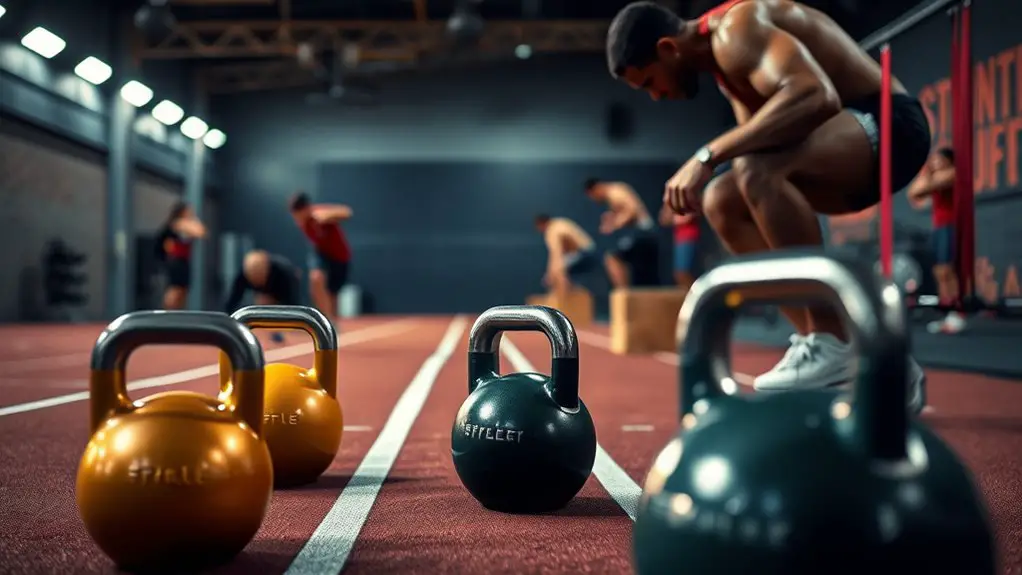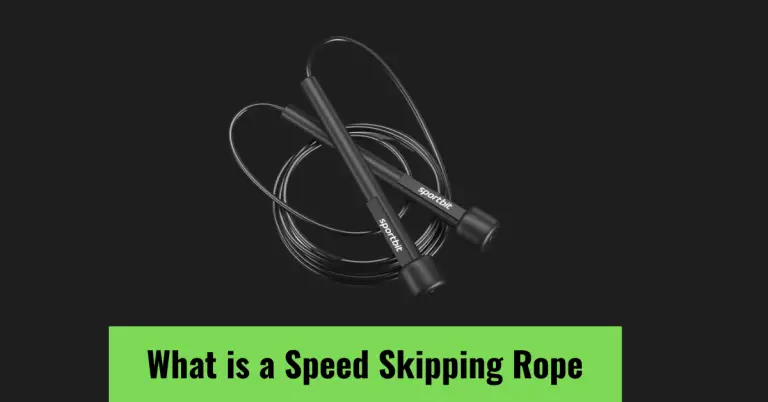The Best Gym Exercises for Faster Sprinting

To sprint faster, focus on exercises like squats, deadlifts, and lunges for building strength and stability. Incorporate box jumps and plyometric drills to develop explosiveness and agility. Leg presses and hip thrusts will enhance overall leg and glute strength. Don’t forget about core exercises to support your sprinting mechanics. Adding resistance through bands or weights can give you an extra edge. If you’re keen to improve your speed further, there are plenty more strategies to explore.
Squats: Building Lower Body Strength

When you want to improve your sprinting speed, incorporating squats into your routine can be a game changer. Squats build lower body strength, which is vital for powerful sprints. By focusing on squat variations like bodyweight squats, goblet squats, or front squats, you can target different muscle groups while maintaining a safe form.
The benefits of squats extend beyond strength; they enhance stability and balance, key for maintaining speed during a sprint. Plus, they engage your core, promoting overall athleticism. To guarantee safety, start with lighter weights and prioritize proper technique over heavy lifting. Additionally, incorporating skipping rope into your training can further improve your cardiovascular fitness, which is essential for sustaining speed during sprints.
Gradually increase the intensity as you become more comfortable. Remember, it’s important to listen to your body and rest when needed. Incorporating squats into your sprint training can lead to significant improvements, helping you achieve your speed goals while minimizing the risk of injury.
Deadlifts: Enhancing Power and Stability
Deadlifts are a powerhouse exercise that can greatly enhance your sprinting performance by building overall strength and stability. Incorporating deadlift variations, like sumo and Romanian deadlifts, can target different muscle groups, ensuring a balanced workout. These variations also help prevent injuries by promoting proper form and muscle engagement.
When performing deadlifts, focus on maintaining a neutral spine and using a comfortable grip to protect your back and joints. Strengthening your grip strength is essential, as it stabilizes the weight during lifts and translates to better control in your sprints.
Start with lighter weights to master the technique before progressing. Always listen to your body; if something feels off, don’t hesitate to adjust or consult a trainer. With consistent practice, deadlifts will not only boost your power but also enhance your overall athletic performance, paving the way for faster sprinting.
Lunges: Improving Balance and Flexibility

Lunges are a fantastic way to enhance your balance and flexibility, both essential for sprinting performance. By incorporating various lunge techniques into your routine, you’ll not only strengthen your legs but also improve your overall stability. Let’s explore how these exercises can make a difference in your sprinting speed.
Balance Enhancement Techniques
While many exercises focus on strength and speed, incorporating balance enhancement techniques like lunges can greatly improve your sprinting performance. Lunges serve as effective balance drills that challenge your stability and coordination, making them essential for any sprint training regimen. You’ll want to start with basic lunges, ensuring your form is correct to avoid injury. Focus on keeping your front knee aligned over your ankle as you lower your back knee toward the ground. As you progress, try variations like lateral lunges or walking lunges for added stability exercises. These variations not only enhance your balance but also engage different muscle groups, leading to a more thorough workout that translates to better sprinting agility and control.
Flexibility Through Lunges
Incorporating lunges into your routine not only sharpens your balance but also greatly boosts your flexibility, which is essential for sprinting. Lunges are effective dynamic stretches that help you prepare your muscles for intense activity. By including various lunge variations, you can target different muscle groups, enhancing your overall performance.
Here’s a simple table to illustrate some lunge types:
| Lunge Variation | Benefits | Safety Tips |
|---|---|---|
| Forward Lunge | Improves hip flexors | Keep your knee behind toes |
| Reverse Lunge | Strengthens glutes | Maintain an upright torso |
| Side Lunge | Enhances lateral movement | Engage your core |
| Walking Lunge | Boosts endurance | Step wide for balance |
| Curtsy Lunge | Targets inner thighs | Control your descent |
Adding lunges to your workouts will guarantee a safer and faster sprinting experience!
Box Jumps: Developing Explosiveness
Box jumps are a powerful exercise that can boost your explosiveness on the track. By mastering the technique, you’ll not only enhance your jumping ability but also improve your overall sprinting performance. Let’s explore how incorporating box jumps into your routine can make a significant difference in your speed.
Technique for Box Jumps
When you aim to enhance your explosiveness for sprinting, mastering the technique of box jumps is crucial. Start with a sturdy box and choose from various box jump variations that suit your skill level. Stand with your feet shoulder-width apart, then squat slightly before jumping explosively onto the box. Focus on your jump landing techniques: land softly with your knees slightly bent, absorbing the impact through your legs. This helps prevent injury and builds strength. After landing, step down carefully rather than jumping off to avoid strain. As you progress, try higher boxes or add variations like lateral jumps. Always prioritize safety over height to guarantee effective training while minimizing the risk of injury.
Benefits for Sprinting Performance
One of the key benefits of box jumps for sprinting performance is their ability to enhance explosiveness. This explosive power translates directly into better sprinting techniques, allowing you to accelerate more quickly off the starting line. By incorporating box jumps into your speed training routine, you’ll develop the fast-twitch muscle fibers essential for sprinting.
To guarantee safety, always start with a box height you’re comfortable with and maintain proper form throughout the exercise. Gradually increase the height as your strength improves. Additionally, focus on landing softly to reduce impact on your joints. With consistent practice, box jumps can greatly boost your speed and overall athletic performance, making them a valuable addition to any sprinter’s workout regimen.
Leg Press: Increasing Overall Leg Strength

Although many people overlook the leg press, it’s a powerful exercise that can greatly boost your overall leg strength. To perform the ideal leg press, focus on proper form and gradually increase weights. Here are some leg press variations you can incorporate into your routine:
- Single-leg leg press: Targets each leg independently for balanced strength.
- Wide stance leg press: Engages inner thigh muscles more effectively.
- Narrow stance leg press: Emphasizes quadriceps for explosive power.
- Feet elevated leg press: Increases range of motion and intensity.
- Slow tempo leg press: Enhances muscle control and hypertrophy.
Incorporating exercises like the goblet squat can further improve leg strength and mobility. Always verify you’re using a safe weight and maintaining good posture. Don’t rush through the movements; controlled reps will yield better results. By integrating these leg press variations into your training, you’ll build a solid foundation for sprinting faster and more efficiently.
Plyometric Drills: Boosting Speed and Agility
Plyometric drills are essential for anyone looking to enhance their sprinting speed and overall agility. These exercises focus on explosive movements, helping you develop powerful legs and quick reflexes. Start with basic plyometric variations like box jumps or jump squats, gradually increasing the intensity as you gain confidence.
To guarantee safety, always warm up properly and pay attention to your landing technique. Aim for soft landings to reduce the risk of injury. Incorporating lateral bounds and tuck jumps can also improve your agility, making you more responsive on the track.
Remember to allow adequate recovery time between sessions, as your muscles need to adapt to this high-intensity training. By consistently practicing these plyometric drills, you’ll notice improvements not only in your sprinting speed but also in your overall athletic performance. So lace up those shoes and get ready to boost your agility!
Core Exercises: Supporting Sprinting Mechanics
To achieve maximum speed on the track, strong core muscles are just as important as powerful legs. Your core stability directly impacts your sprint mechanics, helping you maintain proper form and prevent injury. When your core is strong, it supports your entire body, allowing for more efficient movement. Here are some effective core exercises to incorporate into your routine:
Strong core muscles are crucial for sprinting speed, enhancing stability, form, and overall movement efficiency on the track.
- Planks: Build endurance and stability.
- Russian Twists: Enhance rotational strength.
- Bicycle Crunches: Engage multiple core muscles.
- Dead Bugs: Improve coordination and stability.
- Hanging Leg Raises: Strengthen lower abs and hip flexors.
These exercises not only enhance your sprinting performance but also contribute to your overall athleticism. Always focus on maintaining proper technique to guarantee safety and effectiveness. By prioritizing a strong core, you’ll notice improved speed and efficiency on the track, helping you reach your sprinting goals.
Hip Thrusts: Focusing on Glute Strength
While sprinting relies heavily on powerful leg muscles, don’t underestimate the role of strong glutes in your performance. Hip thrusts are a fantastic exercise for enhancing glute activation and building strength effectively. By focusing on your glutes, you can improve your sprinting speed and overall power.
To perform hip thrusts safely, start by sitting on the ground with your upper back against a bench and your feet flat on the floor. Push through your heels to lift your hips, squeezing your glutes at the top. Make certain your shoulders remain stable and your neck is aligned.
Start with body weight to guarantee proper form before progressing to added resistance. As you get stronger, aim for gradual strength progression. This method not only helps prevent injury but also maximizes your glute strength, contributing positively to your sprinting capabilities. Keep consistency in your routine, and you’ll see improvements in no time!
Resistance Training: Adding Weight for Gains
Building on the foundation of glute strength from exercises like hip thrusts, incorporating resistance training can greatly enhance your sprinting performance. By adding weight, you challenge your muscles to adapt and grow stronger. Here are some effective ways to integrate resistance training safely:
- Use resistance bands to target specific muscle groups while maintaining proper form.
- Incorporate weighted vests during bodyweight exercises for added resistance without compromising stability.
- Focus on compound movements, like squats and deadlifts, to engage multiple muscles.
- Include plyometric exercises to improve explosive power alongside resistance.
- Gradually increase weights to avoid injury and guarantee your body adapts over time.
- Consider integrating the Half-Kneeling Cable Press as a way to engage your core and upper body effectively.
Always listen to your body and prioritize safety when adding resistance. This approach not only strengthens your muscles but also enhances your overall sprinting technique, leading to faster, more powerful runs.
Frequently Asked Questions
How Often Should I Incorporate These Exercises Into My Routine?
You should aim for a balanced training frequency that allows for recovery while incorporating exercise variation. Generally, it’s good to include targeted exercises two to three times a week. Make sure to listen to your body; if you’re feeling fatigued or sore, don’t hesitate to take an extra rest day. Mixing up your routine with different exercises can help prevent overuse injuries and keep your workouts enjoyable and effective.
Can I Do These Exercises at Home Without Gym Equipment?
Did you know that 80% of people believe they can achieve their fitness goals at home? Yes, you can definitely do these exercises at home without gym equipment! Bodyweight exercises like squats, lunges, and push-ups are effective for building strength and speed. Just make certain you maintain proper form to avoid injuries. Incorporating home workouts into your routine can be safe and efficient, helping you stay on track with your fitness goals.
What Is the Best Warm-Up Before Sprint Training?
Before sprint training, it’s essential you warm up properly to prevent injuries. Start with dynamic stretching, like leg swings and high knees, to get your muscles ready. Incorporate mobility drills to enhance your range of motion—think hip circles and walking lunges. These activities increase blood flow and prepare your body for the intensity ahead. Taking 10-15 minutes for this warm-up can make a significant difference in your performance and safety.
How Do I Prevent Injuries While Training for Sprinting?
To prevent injuries while training for sprinting, it’s essential to focus on injury prevention techniques. Start with proper warm-ups to prepare your muscles, and always listen to your body’s signals. Incorporating recovery techniques like stretching, hydration, and rest days can greatly reduce the risk of strain. Consider cross-training to strengthen different muscle groups and avoid overuse. Remember, taking care of your body now guarantees you’ll sprint faster and safer in the long run.
Should I Combine Sprinting With These Gym Exercises for Optimal Results?
Imagine your body as a finely-tuned machine, each part working in perfect harmony. When you combine sprinting with targeted gym exercises, you’re creating that beautiful gym synergy. The benefits of sprinting are undeniable, but by incorporating strength training, you’re also protecting yourself from injury. Just like a well-crafted symphony, balance is key. So yes, blend them together for ideal results, and you’ll reach your goals faster while staying safe!





